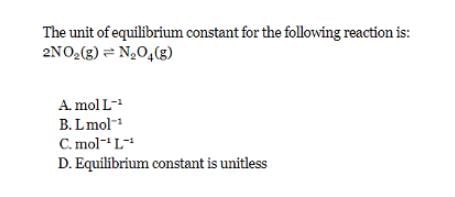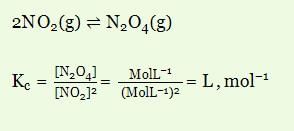Chemistry Exam > Chemistry Tests > Physical Chemistry > Test: Reaction Order & Elementary Rate Law - Chemistry MCQ
Test: Reaction Order & Elementary Rate Law - Chemistry MCQ
Test Description
10 Questions MCQ Test Physical Chemistry - Test: Reaction Order & Elementary Rate Law
Test: Reaction Order & Elementary Rate Law for Chemistry 2025 is part of Physical Chemistry preparation. The Test: Reaction Order & Elementary Rate Law questions and answers have been
prepared according to the Chemistry exam syllabus.The Test: Reaction Order & Elementary Rate Law MCQs are made for Chemistry 2025 Exam. Find important
definitions, questions, notes, meanings, examples, exercises, MCQs and online tests for Test: Reaction Order & Elementary Rate Law below.
Solutions of Test: Reaction Order & Elementary Rate Law questions in English are available as part of our Physical Chemistry for Chemistry & Test: Reaction Order & Elementary Rate Law solutions in
Hindi for Physical Chemistry course. Download more important topics, notes, lectures and mock
test series for Chemistry Exam by signing up for free. Attempt Test: Reaction Order & Elementary Rate Law | 10 questions in 20 minutes | Mock test for Chemistry preparation | Free important questions MCQ to study Physical Chemistry for Chemistry Exam | Download free PDF with solutions
Test: Reaction Order & Elementary Rate Law - Question 1
The mlecularity of the following single step reaction is ___________.
aA + bB → pP
aA + bB → pP
Detailed Solution for Test: Reaction Order & Elementary Rate Law - Question 1
Test: Reaction Order & Elementary Rate Law - Question 2
Reaction corresponding to stoichiometric equation is called __________
Detailed Solution for Test: Reaction Order & Elementary Rate Law - Question 2
Detailed Solution for Test: Reaction Order & Elementary Rate Law - Question 3
Test: Reaction Order & Elementary Rate Law - Question 4
What is the relative rate of reaction for the given reaction.
2A + 9B → 7C + 4D
Detailed Solution for Test: Reaction Order & Elementary Rate Law - Question 4
Test: Reaction Order & Elementary Rate Law - Question 5
Molecularity is ___________ value and order is ___________ value.
Detailed Solution for Test: Reaction Order & Elementary Rate Law - Question 5
Test: Reaction Order & Elementary Rate Law - Question 6
The rate constant for a first order reaction depends on _____________
Detailed Solution for Test: Reaction Order & Elementary Rate Law - Question 6
Test: Reaction Order & Elementary Rate Law - Question 7
The overall reaction order for A + B → C + D is two. It implies that ______
Detailed Solution for Test: Reaction Order & Elementary Rate Law - Question 7
Test: Reaction Order & Elementary Rate Law - Question 8
The units of rate constant of nth order is ___________
Detailed Solution for Test: Reaction Order & Elementary Rate Law - Question 8
Test: Reaction Order & Elementary Rate Law - Question 9
The overall order of reaction for –rA = kCA0.7CB1.3 is _______
Detailed Solution for Test: Reaction Order & Elementary Rate Law - Question 9
Test: Reaction Order & Elementary Rate Law - Question 10
Molecularity refers to an elementary reaction.
Detailed Solution for Test: Reaction Order & Elementary Rate Law - Question 10
|
90 videos|144 docs|67 tests
|
Information about Test: Reaction Order & Elementary Rate Law Page
In this test you can find the Exam questions for Test: Reaction Order & Elementary Rate Law solved & explained in the simplest way possible.
Besides giving Questions and answers for Test: Reaction Order & Elementary Rate Law, EduRev gives you an ample number of Online tests for practice
















